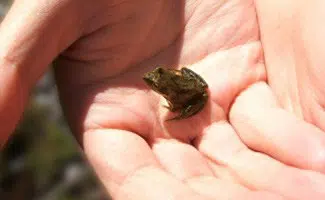When you purchase through links on our site, we may earn a commission. Here’s how it works.

The Paedophryne Amauensis
Paedophryne amanuensis is a newly discovered frog species found in Papua, New Guinea by a team of researchers from the United States. This tiny frog measures just 7 mm or .27 inches long and goes down in the record books as the world’s smallest frog. The full grown adult Paedophryne amanuensis frog still only measures around 7.7 mm at its largest which is why this species overthrows the Brazilian gold frog. The Paedophryne amanuensis was not the only species discovered on this research trip, researchers were also able to find a larger relative of Paedophryne amanuensis, Paedophryne swiftorum. The Paedophryne amanuensis makes its home in leaf litter on the forest floor like many other small lizards and frogs. The deep green color of this tiny amphibian is related to this woodland habitat and allows this small reptile to camouflage itself adequately from predators.
The Discovery of Paedophryne Amauensis

What is Known about the Paedophryne Amauensis
Paedophryne Amauensis Hide in Leaf Litter on the Forest Floors
Researchers so far know that Paedophryne amanuensis prefers to live in thick leaf litter on the forest floors in the eastern forests of Papua, New Guinea. Being such small creatures with dark camouflage the Paedophryne amanuensis are able to hide in the deeper litter and escape not only predators but also researchers! Small frog species like the Paedophryne amanuensis are not unknown to small forests around the world. Damp leaf litter and tropical climates with high levels of moisture and abundant insect populations make the ideal setting for smaller frog species who would stand no chance in less sheltered environments.
There are Many Unique Factors about the Paedophryne Amanuensis
The Paedophryne amanuensis is unique in comparison to many other frog species, in that it does not have a tadpole stage in its lifecycle. Rather than hatching as tadpoles as most frogs do, the young Paedophryne amanuensis hatch as small hopping frogs that are already completely formed. Incredibly even right after hatching, these amazing frogs can jump as much as thirty times their body length. The Paedophryne amanuensis feeds on small invertebrates that can be found on the forest floors. Another unique feature about this small frog species is the incredibly high pitched sounds that these frogs make when calling for mates. The 8400 – 9400 Hz sound that these frogs make is similar to the sound of insects and is what drew researchers to the frog initially. When hearing the peeps of these small crepuscular frogs researchers were curious to pinpoint the sound and it was then that these tiny frogs were discovered.
The Paedophryne Genus
The Paedophryne genus of frog is considered as a microhylid frog type. The name Paedophryne translates from the Greek words “paedos” meaning child and “phryne” meaning toad or frog. There are currently six known species within the Paedophryne genus and all six of these species are recognized for their incredibly minute size. The six known species of the Paedophyryne genus include: Paedophryne kathismaphlox, Paedophryne oyatabu, Paedophryne dekot, Paedophryne verrucosa, Paedophryne amanuensis and Paedophryne swiftorum. All of these species have been newly discovered within the past three years. The Paedophryne genus is a genus that falls in to the Asterophryinae subfamily of microhylid frogs. There are currently seventy one recognized species and nine recognized genera in the Asterophryinae subfamily.
The Microhylidae Frog Family
Microhylid frogs are frogs that fall in to the Microhylidae family. This frog family is the largest of all frog families and contains some 495 different species that are found all over the world. Most commonly these frogs are found in warm temperate or tropical regions of the world including: North and South America, eastern India, Sri Lanka, New Guinea, Australia, Madagascar and Africa. Each species within the Microhylidae family are known for being incredibly small and can be found living on forest floors, in underground burrows and in trees. There are nine known subfamilies of the Microhylidae frog family, these include Asterophryinae, Brevicipitinae, Cophylinae, Dyscophinae, Genyophryninae, Melanobatrachinae, Microhylinae, Phrynomerinae and Scaphiophryninae.
Why Papua, New Guinea?



